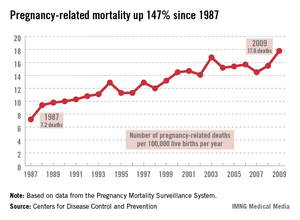SAN DIEGO – Fewer than 1% of pregnant women present to the intensive care unit critically ill, but when they do, "there’s often significant morbidity and mortality," Dr. Kimberly S. Robbins said at the University of California, San Diego Critical Care Summer Session.
Dr. Robbins, an assistant professor in the UCSD department of anesthesiology, noted that the greatest physiologic changes of pregnancy affect the pulmonary and cardiovascular systems, and the most common conditions that land obstetric patients in the intensive care unit (ICU) are obstetric hemorrhage and complications of the hypertensive disorders of pregnancy.
"In general we consider pregnant patients to be potentially difficult airway patients, or difficult to intubate," she said. "That’s because pregnant patients are predisposed to edema and swollen airways." This patient population also has increased minute ventilation, "mostly because of an increase in tidal volume but also due to an increase in respiratory rate. They have increased oxygen demand, an increased metabolic rate because they are supplying oxygen to another being, and they have decreased functional residual capacity, which is the amount of volume that’s left in the lung after passive expiration."
From a cardiovascular standpoint, pregnant patients have an increased cardiac output both from an increased stroke volume and an increased heart rate. "During pregnancy the heart is shifted upward and to the left," Dr. Robbins added. "That impacts where you place your hands for CPR [cardiopulmonary resuscitation]. We also commonly see a decrease in systemic vascular resistance and diastolic blood pressure, as well as aortocaval compression. This means that the large gravid uterus can compress the great vessels. Not only does that impede venous return to the heart, but you can also get a decrease in the outflow of blood from the heart into the aorta."
Pregnant patients also experience a 45% increase in blood volume. This makes them relatively anemic "because there’s a relative increase in the plasma volume over the red cell volume," she explained. "Normal hemoglobin in a pregnant patient is around 11 or 12 g/dL."
Neurologically, pregnant patients can experience enhanced toxicity of local anesthetics used during cesarean section and during labor and delivery. Such complications "can land a person in the ICU," Dr. Robbins said. "Pregnant patients also have decreased anesthetic requirements. This is important as we’re titrating our sedatives or analgesics in the ICU. They also have distention of their epidural venous plexus. This makes it more likely that we may inadvertently inject local anesthetic into the vasculature and cause complications."
From a gastrointestinal standpoint, pregnant patients are considered full-stomach patients at all times, "even if they’ve had nothing by mouth," she said. "This is believed to occur after the first trimester, typically because of increased gastric pressure and decreased lower esophageal sphincter tone. During labor we see decreased gastric emptying, increased gastric volume, and decreased gastric pH levels."
Pregnancy also impacts renal function by increasing renal blood flow and glomerular filtration rate. In addition, it can cause decreased levels of creatinine and mild glucosuria and proteinuria. From an endocrine standpoint, pregnant patients have impaired glucose tolerance, increased sensitivity to insulin, and an increase in T3, T4, and thyroid size.
Dr. Robbins went on to discuss preeclampsia, a hypertensive disorder that causes 50,000-70,000 deaths worldwide per year. She characterized the condition as a triad of hypertension, proteinuria, and edema that usually occurs during a woman’s first pregnancy. Other factors include molar pregnancy, multiple gestation, and vascular endothelial disorders. General diagnostic criteria include at least 20 weeks gestation, new-onset hypertension (blood pressure of 140/90 mm Hg or 30/15 increase x2 at least 6 hours apart), proteinuria of greater than 0.3 g/day, and generalized edema or weight gain greater than 5 pounds/week.
Diagnostic criteria for severe preeclampsia include a systolic blood pressure of greater than 160 mm Hg or a diastolic blood pressure of greater than 110 mm Hg sustained, proteinuria of greater than 5 g/day, and signs of end organ dysfunction.
The pathophysiology of preeclampsia is unknown. "This is probably the greatest area of research in obstetrics and obstetric anesthesiology," Dr. Robbins said. "Some have postulated that it is a dysfunction of the maternal endothelium that develops because of abnormal formation of the placenta such that the placenta does not normally invade into the maternal vasculature. There are vasoactive substances that are released into the maternal circulation. That causes dysfunction of the maternal endothelium."
Patients with mild preeclampsia can be treated expectantly, but if the gestational age is greater than 37 weeks delivery should be considered. "The hallmark of treatment is prompt delivery of the fetus," she said.



